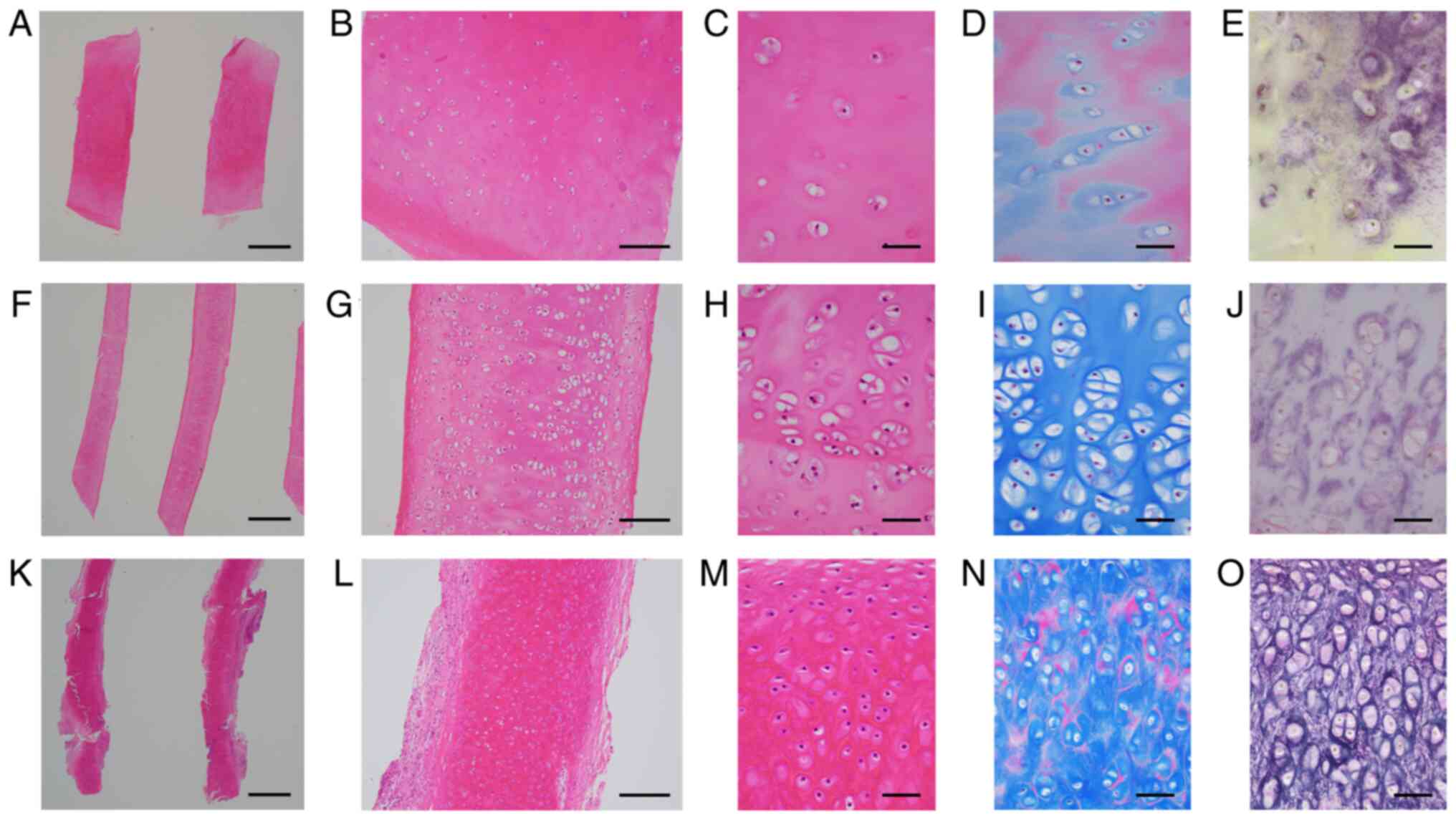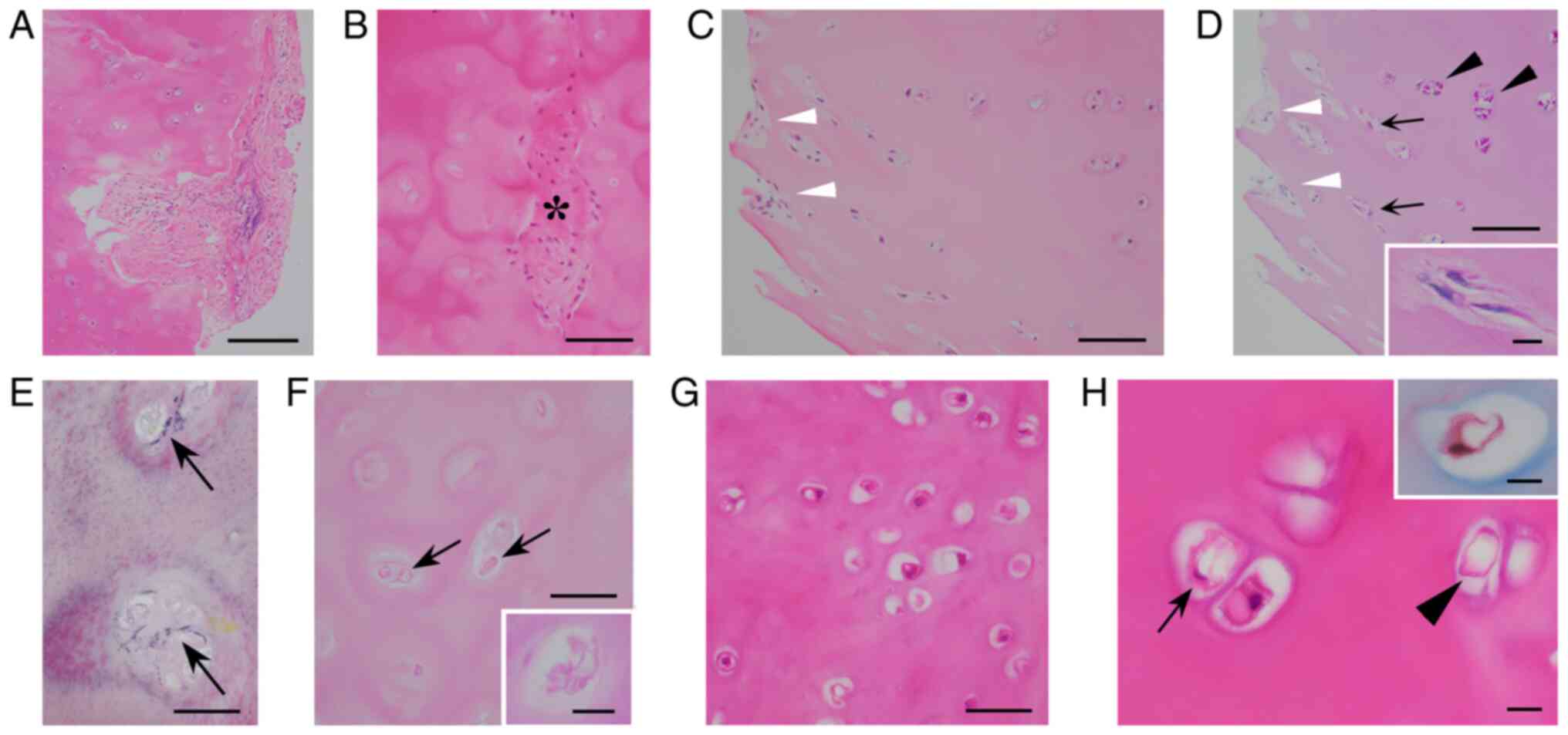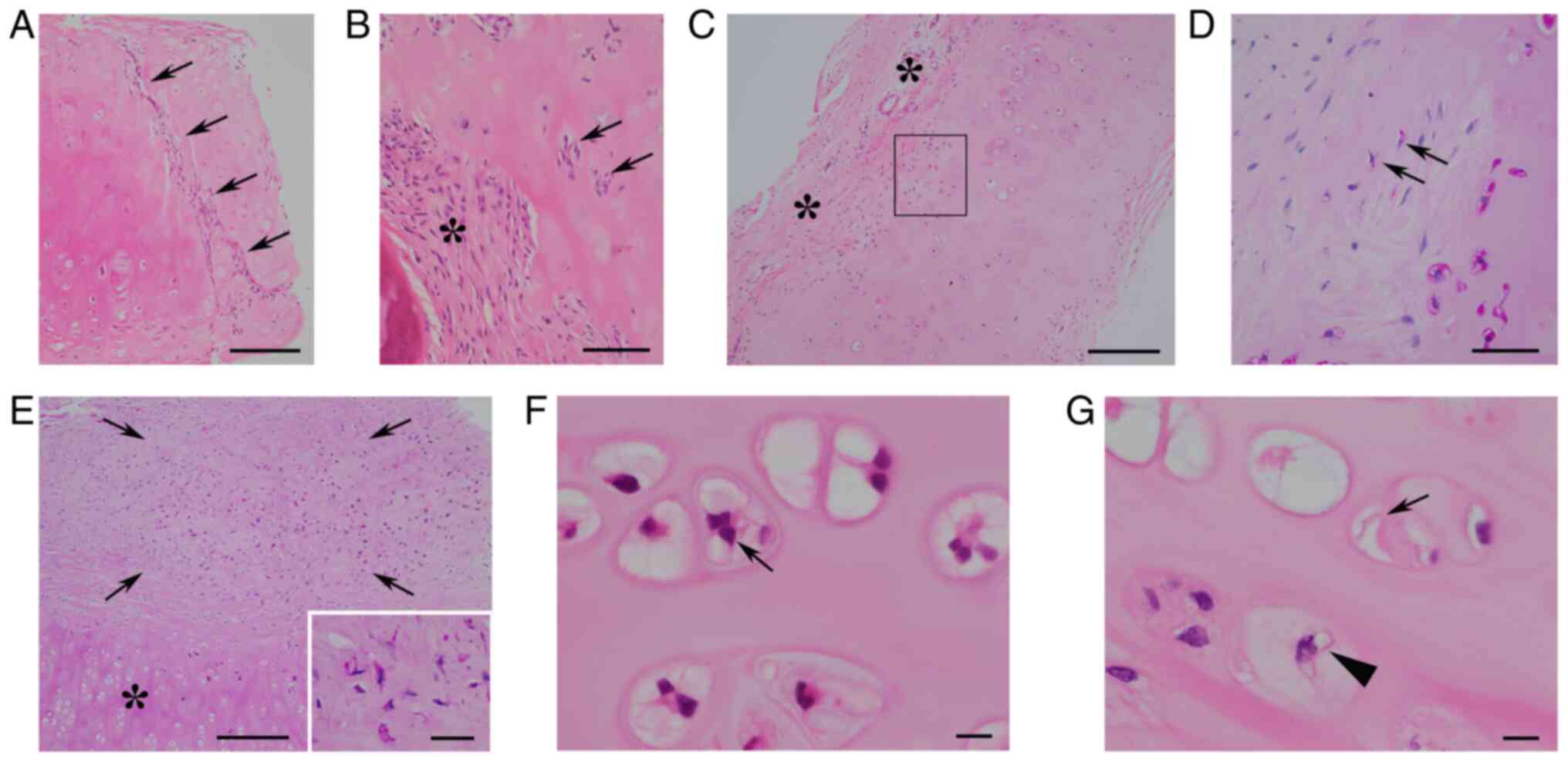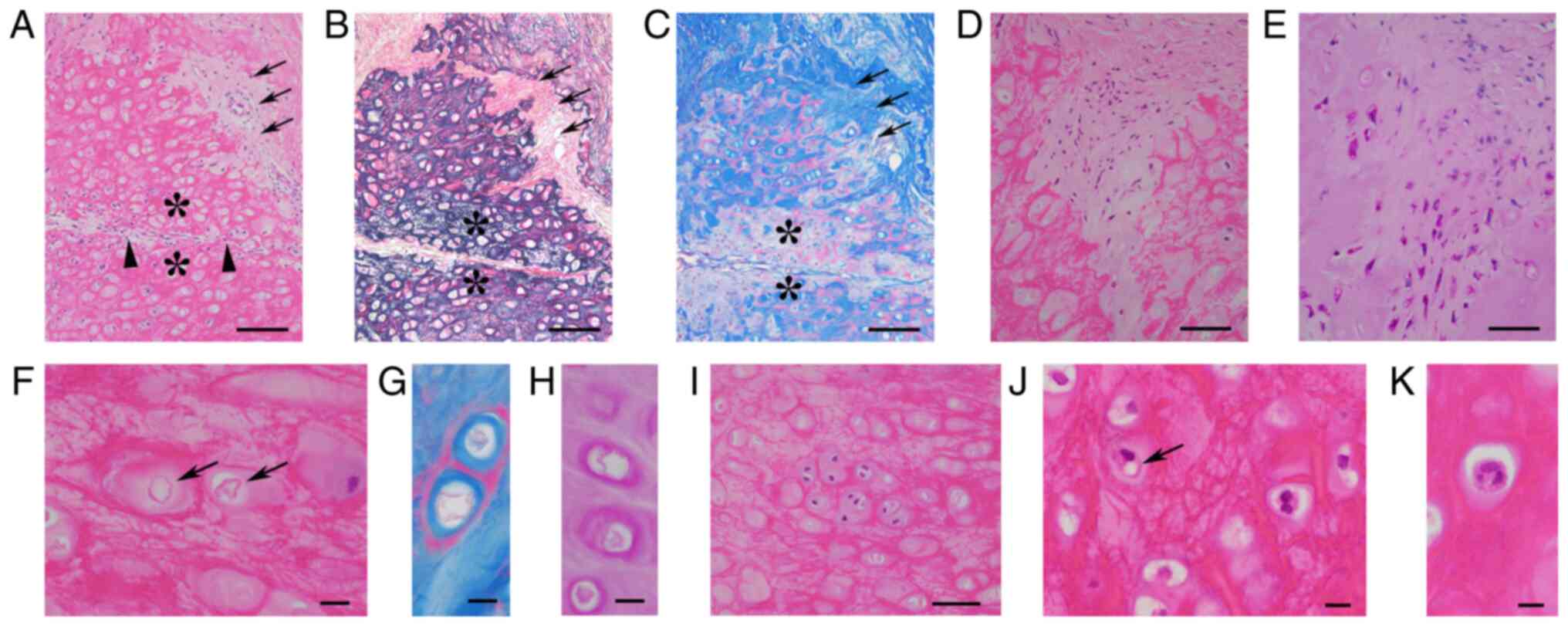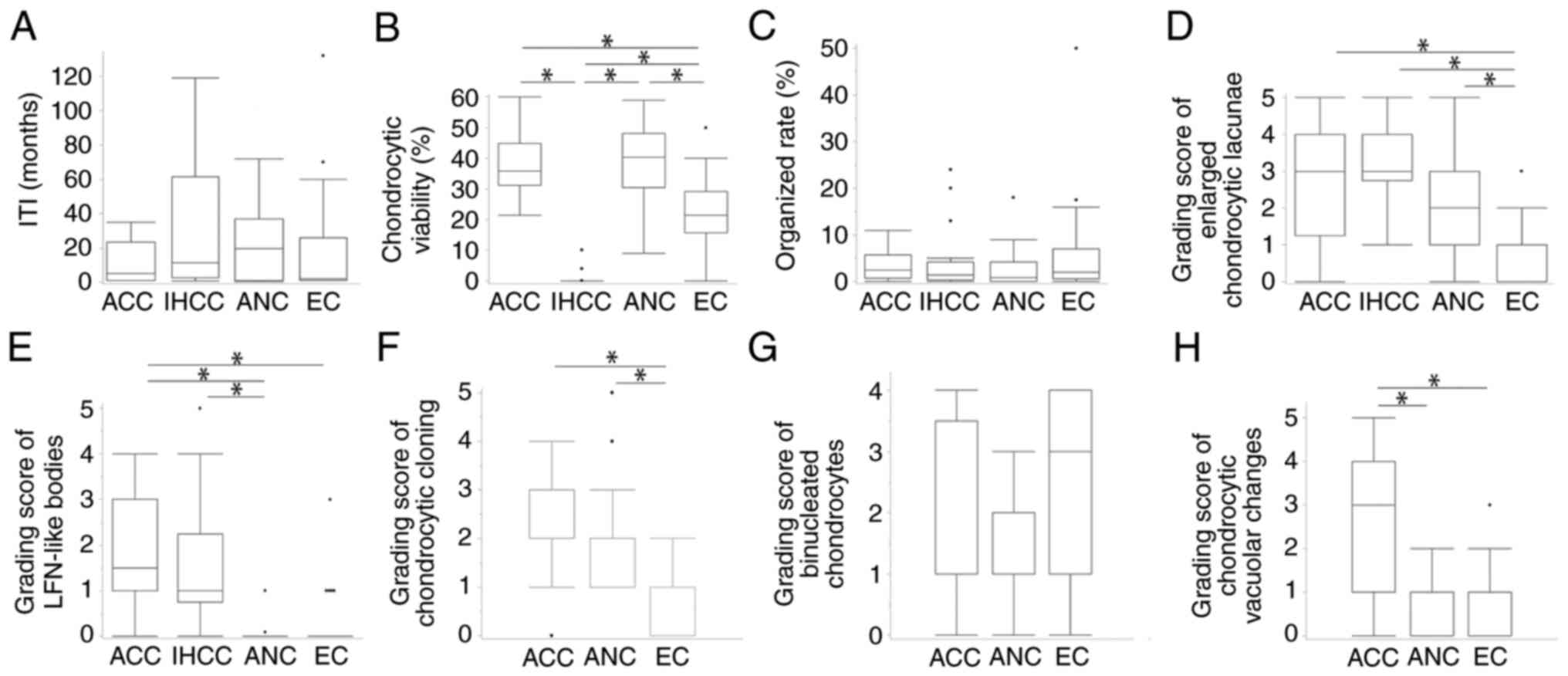Implanted cartilaginous grafts following rhinoplasty: A retrospective histopathological study
- Authors:
- Published online on: October 3, 2024 https://doi.org/10.3892/etm.2024.12739
- Article Number: 449
Abstract
Introduction
Rhinoplasty is one of the most commonly performed plastic/cosmetic surgeries worldwide (1-4). Rhinoplasty is a repositioning technique of the nasal skeleton and soft tissues to improve function and/or appearance (1-4). Rhinoplasty includes septoplasty (1,2,5), septorhinoplasty (6), nasal reconstruction (7,8), nasal dorsum augmentation (1,2,9,10), turbinoplasty (1,2), and nasal tip plasty/modification (1,2,4,9,10). Rhinoplasty frequently uses autologous cartilaginous grafts, homologous cartilaginous grafts and/or alloplastic/artificial grafts to correct contour deformities and restore structural support (1,3,4). Autologous cartilages are harvested from the 6-8th rib, nose, and/or ear of patients themselves (1,5,7-16) and homologous ones are usually composed of cadaveric rib (5,11,16). Surgical techniques and management for rhinoplasty have progressively improved (1,2,9). Nevertheless, unexpected events or complications can occur (1-3,9-11), and revision rhinoplasty with removal of implanted cartilage may be required (9,14,16). Such events or complications include nasal deformity/deviation/asymmetry, infection, skin necrosis, bleeding/hematoma and vestibular stenosis (1,2,9). Pathological examination of the removed cartilaginous grafts can provide useful information to surgeons. Previous investigations regarding cartilage implantation have focused on cartilaginous viability and stability in human (13-15) or animal models (17-20) although they also have described calcification/ossification (13,18,19), vascularization or granulation-fibrosis (13-15,17-19), chondrocytic cloning (14), and mild lymphoid infiltration (15) in implanted cartilages. To date, the detailed histopathological features/alterations of implanted cartilages remain poorly understood although cartilaginous changes are frequently mentioned in osteoarthritic conditions, rheumatoid arthritis, and some inherited diseases (21-23). In this study, we examined surgically removed cartilages that had been implanted during a previous rhinoplasty, and attempted to define their histopathological features/changes. To the best of our knowledge, the present study is the first to describe the detailed histopathological findings of implanted human cartilages in a relatively larger series.
Materials and methods
Ethics approval
The present study was a retrospective study performed according to the principles of the Declaration of Helsinki, and was approved by the Ethical Review Board of the National Defense Medical College (No. 4804; April 27, 2023).
Patients, removed cartilaginous grafts, and clinicopathological investigation
Hematoxylin and eosin (H&E)-stained, Masson trichrome (MT)-stained, periodic acid-Schiff (PAS)-stained, and elastica van Gieson (EVG)-stained glass slides of 83 removed cartilaginous grafts were available from Ginza Sumirenohana Clinic and were examined for pathology. All grafts were surgically removed from 42 patients (2 men and 40 women), with a median age of 28.0 years (range, 21-47 years), during correction/revision rhinoplasty at Ginza Sumirenohana Clinic, Tokyo, Japan, between January 2016 and March 2023. All specimens were fixed with 10-20% buffered formalin, paraffin-embedded, and routinely processed. Clinical information including time interval between implantation and graft removal, termed implantation time interval (ITI), was available from the request forms for pathological examination, and additionally obtained from the attending physician at the clinic. According to previous investigations (17,20), we defined chondrocytic viability as nucleated cell count (%) within chondrocytic lacunae. The organized rate of chondroid matrix was calculated as the replacement-fibrotic areas (%) within possible initial chondroid areas. Pathological changes were graded as follows: 0, none; 1, mild; 2, mild to moderate; 3, moderate; 4, moderate to marked; and 5, marked. Histological assessment was performed using an Olympus BX51 microscope (Olympus, Tokyo, Japan).
Statistical analysis
We analyzed the clinicopathological differences between cartilaginous types using the chi-square test, Fisher's exact test, Mann-Whitney U-test with or without Bonferroni correction, and Kruskal-Wallis H-test. Statistical significance was set at P<0.05. To compare data among ≥3 cartilage types, Kruskal-Wallis H-test analysis was applied first. If there was a significant difference of variables between them, we further analyzed difference between two cartilage types using Mann-Whitney U-test with Bonferroni correction.
Results
Clinical findings and histological type of removed cartilaginous grafts
Table I shows a summary of clinical findings. ITI ranged from 0.3 to 132 months (median, 18.0 months). Main complaints/reasons for surgery included nasal deformity (24 patients), nasal discomfort (15 patients), and skin thinning at the implantation site (10 patients). Based on histological characteristics (7,24-26), removed cartilages were divided into articular/costal hyaline cartilages, nasal (hyaline) cartilages (NCs), and elastic cartilages. Additional clinical information concluded that articular/costal hyaline cartilages corresponded to costal cartilages (CCs) composed of autologous CCs (ACCs) and irradiated homologous CCs (IHCCs). NCs were subdivided into autologous NCs (ANCs) and irradiated homologous NCs (IHNCs), and all ECs corresponded to autologous ear cartilages (ECs). CCs were usually triangular or diced, and contained evenly distributed chondrocytes/lacunae (Fig. 1A and B). NCs and ECs were frequently elongated and slightly curved (Fig. 1F and K), and were sometimes fragmented. Chondrocytes/chondrocytic lacunae in NCs and ECs were sparse centrally and relatively dense peripherally (Fig. 1G and L). Scattered empty chondrocyte lacunae indicated chondrocyte necrosis. On H&E-stained sections, chondroid matrix in CCs and NCs was slightly eosinophilic and homogeneous, whereas that in ECs was brightly red (Fig. 1C, H and M). MT stain highlighted unstained chondrocytic lacunae, with NC chondrocyte lacunae somewhat larger than those of CCs and ECs (Fig. 1D, I and N). ECs were characterized by a dense elastic meshwork (Fig. 1O). CCs and NCs lacked this dense elastic meshwork, but had occasional EVG-positive fine deposits (Fig. 1E and J). Thirteen grafts were composed of ≥2 different types of cartilages and/or artificial grafts (combined grafts). Consequently, a total of 83 grafts were divided into 14 ACCs only, 16 IHCCs only, 24 ANCs only, 2 IHNCs only, 14 ECs only, and 13 combined grafts (Table II). We examined 16 ACCs (14 ACCs only and 2 ACCs in combined grafts), 18 IHCCs (16 IHCCs only and 2 IHCCs in combined grafts), 33 ANCs (24 ANCs only and 9 ANCs in combined grafts), 2 IHNCs only, and 23 ECs (14 ECs only and 9 ECs in combined grafts).
Histopathological features of removed cartilaginous grafts
Table III summarizes clinicopathological features of the cartilaginous grafts. Granulation-fibrosis surrounded 11 ACCs, 9 IHCCs, 24 ANCs, and 22 ECs. Mild lymphoid infiltration was found in 5 ACCs, 6 IHCCs, 11 ANCs, and 7 ECs. Neutrophilia, suggesting bacterial infection, was not found in any removed cartilages.
Table IIIClinicopathological findings of 83 cartilaginous graftsa surgically removed from 42 patients. |
CCs
All 16 ACCs contained viable chondrocytes. IHCCs were mostly necrotic and 3 IHCCs had a few viable chondrocytes. Median chondrocytic viability was 35.9% in ACCs and 0.0% in IHCCs. Chondroid matrix was partially organized in all ACCs and in 16 IHCCs (Fig. 2A and B). The median organized rate was 2.5% in ACCs and 1.4% in IHCCs. Organizing fibroblasts were not stained with PAS, whereas chondrocytes were PAS-positive. In 6 ACCs, PAS-positive spindle chondrocytes and PAS-negative fibroblastic spindle cells were intermingled near the organized areas, indicating a possible transition between chondrocytes and fibroblasts (Fig. 2C and D). The median grading score of enlarged chondrocytic lacunae of both ACCs and IHCCs was 3.0. Newly developed minimal elastic fibers were found (Fig. 2E) in 8 ACCs and 6 IHCCs. Eosinophilic serpiginous membranous bodies (Fig. 2F) were identified in 15 ACCs and 14 IHCCs. These bodies were red with MT and PAS stains (Fig. 2F, inset), mimicking lipomembranous fat necrosis (LFN) (27,28). The median grading score of these LFN-like bodies was 1.5 in ACCs and 1.0 in IHCCs. Chondrocytic cloning, binucleated chondrocytes, and chondrocytic vacuolar changes (Fig. 2G) were found in 14, 15, and 15 ACCs, respectively, and the median grading score was 2.0, 1.0, and 3.0, respectively. A histological transition between chondrocytic vacuoles and LFN-like bodies was occasionally observed in 2 ACCs (Fig. 2H). In IHCCs, chondrocytic cloning, binucleated chondrocytes, and chondrocytic vacuoles were not observed. Trinucleated chondrocytes were not found in any of the CCs.
NCs. All 35 NCs contained viable chondrocytes. Median chondrocytic viability was 38.8% in ANCs and 25.8% in IHNCs, with no significant difference between them (P=0.105; Mann-Whitney U-test without Bonferroni correction). Median organized rate was 0.9% in ANCs and 0.01% in IHNCs. Organizing fibroblasts invaded chondroid matrix in a striated (Fig. 3A) or nested (Fig. 3B) fashion. There was a possible transition between PAS-positive chondrocytes and fibroblasts in 3 ANCs (Fig. 3C and D). In 1 ANC, there was a fibrous nodule containing many PAS-positive spindle cells (Fig. 3E), suggesting fibrocartilaginous metaplasia of ANC. The median grading score of enlarged chondrocytic lacunae was 2.0 in ANCs and 4.0 in IHNC. Elastic fibers were not observed in NCs. LFN-like bodies were found in 3 ANCs, but not in IHNCs. The median grading scores of chondrocytic cloning and binucleated chondrocytes in ANCs were 2.0 and 1.0, respectively, and those in IHNCs were 3.0 and 2.0, respectively. Trinucleated chondrocytes were observed in 8 ANCs (Fig. 3F) and in 2 IHNCs. The median grading score of chondrocytic vacuolar changes in both ANC and IHNC was 1.0. Chondrocytic vacuoles and LFN-like bodies were focally intermingled in 1ANC (Fig. 3G).
ECs. Median chondrocytic viability and median organized rate of removed ECs were 21.4 and 2.0%, respectively. Organized areas consisted of neovascularized fibrous tissues lacking elastic meshwork (Fig. 4A and B). Near organized areas in 15 ECs, there were patchy degenerated chondroid areas lacking collagenous matrix blue stained by MT but preserving the elastic meshwork (Fig. 4A-C; asterisks). In 1 EC, there was a possible transition between chondrocytes and fibroblasts (Fig. 4D and E). The median grading score of enlarged chondrocytic lacunae was 1.0. LFN-like bodies (Fig. 4F-H) were observed in 5 ECs, and the median grading score was 0. The median grading scores for chondrocytic cloning (Fig. 4I) and binucleated chondrocytes (Fig. 4J) were 1.0 and 3.0, respectively. Trinucleated chondrocytes (Fig. 4K) were found in 2 ECs. The mean grading score of chondrocytic vacuolar changes (Fig. 4J) was 1.0. The histological transition between vacuolar chondrocytes and LFN-like bodies was unclear in all ECs.
Statistical analysis of clinicopathological findings of implanted cartilaginous grafts
The incidence of ossification in ACC, IHCC, ANC, and EC was 12.5, 11.1, 15.1, and 0%, respectively (Table III). There was no significant difference between them (P=0.549, Fisher's exact test). The incidence of lymphoid infiltration in ACC, IHCC, ANC, and EC was 31.3, 33.3, 33.3, and 30.4%, respectively (Table III), and there was no significant difference between them (P=0.996, nxm chi-square test). Fig. 5 shows comparisons of other clinicopathological findings among cartilaginous types. Kruskal-Wallis H-test revealed no significant difference of ITI or organized rate between ACC, IHCC, ANC, and EC (Fig. 5A and C) and no significant difference of grading score for binucleated chondrocytes between ACC, ANC, and EC (Fig. 5G). On the other hand, Kruskal-Wallis H-test demonstrated a significant difference of grading score for chondrocytic viability, enlarged chondrocytic lacunae, and LFN-like bodies among ACC, IHCC, ANC, and EC, (all, P<0.001) and a significant difference of grading score for chondrocytic cloning and vacuolar change between ACC, ANC, and EC (both, P<0.001). Chondrocytic viability in IHCC was lower than that in the others (all, P<0.001), and that in ECs was lower than that in ACCs and ANCs (both, P<0.001) (Fig. 5B). The grading score of enlarged chondrocytic lacunae was lower than that of the others (all, P<0.001) (Fig. 5D). The grading score of LFN-like bodies in ACCs and IHCCs was higher than that in ANCs and ECs (Fig. 5E). The grading score of chondrocytic cloning features in ECs was lower than that of ACCs and ANCs (both, P<0.001) (Fig. 5F). The grading score of chondrocytic vacuolar changes in ACCs was significantly higher than that in ANCs and ECs (both, P<0.001) (Fig. 5H). The higher grading scores of LFN-like bodies in ACCs were closely associated with higher grading scores of chondrocytic vacuolar changes (P=0.026), but this was not found in ANCs or ECs (Table IV). A close relationship between the presence of trinucleated chondrocytes and increasing binucleated chondrocytes was found in ANCs (P=0.001), but not in ECs (Table V).
Table IVRelationship between eosinophilic membranous bodies and chondrocytic vacuolar changes in removed cartilaginous grafts. |
Discussion
The present histological examination could distinguish NCs and elastic cartilages from articular cartilages/CCs. However, because of close histological similarities, discrimination of CCs from articular cartilages is challenging and would require additional clinical information. NCs are known to be hyaline cartilages containing elastin elements (24,29). However, in the present NCs, elastic fibers were not found. On the other hand, in 14 of 34 CCs (32.4%), possibly newly developed elastic fibers were observed although they were focal and minimal. Radiation induces chondrocytic necrosis, which would be a hallmark for irradiated history. Indeed, in this study, chondrocytic viability of IHCC was significantly lower than that of ACC. However, there was no significant difference of chondrocytic viability between IHNCs and ANCs. Sinclair and Walsh (30) measured chondrocyte numbers per square millimeter of IHCCs ranging from 591 and 281, which is higher than chondrocytic viability in the current IHCCs. These findings would be accounted for by the difference in radiation dose. In the present study, chondrocyte viability in IHNC was high and this was attributed to low radiation dose.
Cartilages are nourished by diffusion or permeation from surrounding tissues or fluid, without direct vascular supply (19,25,26,31). A previous investigation (19) suggested that smaller implanted cartilages are more viable than larger ones because smaller cartilages can receive richer diffusion nourishment. Greater chondrocyte viability avoids organization or absorption of chondroid matrix, which would play a critical role in the stability of implanted cartilages on rhinoplasty (13-15). In the current study, however, chondrocytic viability of ECs was significantly lower than ACCs, ANCs, and ECs, but there was no significant difference of organized rate among them. Vila et al (11) also reported no difference in absorption rate between IHCCs and ACCs. These findings suggest that the stability of implanted chondroid matrix does not depend on only chondrocyte viability. Furthermore, the current study revealed a possible transition between chondrocytes and fibroblasts. Dedifferentiation or fibroblastic transformation of chondrocytes can occur in osteoarthritic articular cartilages (23). These findings indicate a possibility that viable chondrocytes not only preserve chondroid matrix but also transform into fibroblasts, inducing organization. In the present study, such possible transition between chondrocytes and fibroblasts was not rare (37.5% of ACCs, 9.1% of ANCs, and 4.3% of ECs). The molecular mechanism regarding the transition of chondrocytes into a fibroblastic phenotype remains poorly understood, although the transition is related to decreased gene expression of SOX9 and COL2A1, suppressed production of aggrecan, and increased expression of COL1A1 (32,33). Such transition would lead to a mechanically weak chondroid matrix (33), possibly resulting in provoking unexpected degeneration and/or resorption of the implanted cartilaginous graft. In fact, in one ANC, a possible fibrocartilaginous metaplasia was found. However, the current study failed to reveal pathogeneses determining whether chondrocytes avoid or induce organization or fibrocartilaginous metaplasia. The association of chondrocyte dedifferentiation with the stability of implanted cartilages is unclear. To elucidate these points, further investigations are required.
The current study identified unique LFN-like bodies in 93.8% of ACCs, 77.8% of IHCCs, 9.1% of ANCs, and 21.8% of ECs. To our knowledge, LFN-like bodies in cartilages have not been mentioned previously in any cartilaginous conditions, including osteoarthritis, rheumatoid arthritis, or metabolic diseases (21-23). We initially predicted LFN-like bodies as sclerotic changes of chondrocytic lacunar ‘capsules’ (25). However, in 2 ACCs and 1 ANC, an occasional histological transition between LFN-like bodies and chondrocytic vacuoles was observed. There was a statistically significant relationship between chondrocytic vacuolar changes and LFN-like bodies in ACCs. These findings suggest that LFN-like bodies are a vacuolar change-related necrotic form of chondrocytes themselves. Chondrocytic vacuolar changes can occur in the hypertrophic zone of the maturing epiphyseal growth plate (23) and in achondrogenesis (21,23) and fibrochondrogenesis (23). Chondrocytic vacuoles in achondrogenesis indicate some metabolic abnormalities in chondrocytes (21). The presence of implanted chondrocytic vacuoles may imply similar metabolic abnormalities.
The current study of implanted cartilages also detected other histological features, such as enlarged chondrocytic lacunae, chondrocytic cloning, increased binucleated chondrocytes, and trinucleated chondrocytes. Enlarged chondrocytic lacunae represent degenerative changes of chondroid matrix. Chondrocytic cloning is associated with possible intrinsic cartilaginous repair or regeneration in osteoarthritic articular cartilages (22,23). Therefore, both chondrocyte cloning and more binucleated chondrocytes in implanted cartilages may indicate chondrocytic reactive proliferation, although binucleated chondrocytes are common in normal articular (23) and nasal septal (13) cartilage. Trinucleated chondrocytes would not be recognized in normal cartilages, but can occur in atelosteogenesis (23). The presence of trinucleated chondrocytes in the present ANCs was statistically associated with more binucleated chondrocytes. However, this tendency was unclear in ECs and trinucleated chondrocytes were not found in ACCs despite frequent binucleated chondrocytes. These findings suggest differences of chondrocytic natures or responses among CC, NC, and EC. In this study, the grading score of chondrocyte cloning in ECs was significantly lower than that in ACCs and ANCs. Similarly, the grading score of enlarged chondrocyte lacunae in ECs was lower than that in ACCs, IHCCs, and ANCs. These differences would contribute to the amount of elastic fibers in the chondroid matrix. Elastic fibers in ECs are more prominent compared with those in CCs and NCs, and tightly surround the chondrocytes and their lacunae. Therefore, chondrocytes are less likely to form clones and lacunae would be less prone to enlarge. The relationship between these histopathological differences and the outcomes of implanted cartilages remains unclear in the present study. However, further studies would provide histopathological markers that predicts unexpected graft resorption and future weakening of cartilaginous quality in rhinoplasty.
In 15 ECs, near organized areas, there were patchy degenerated chondroid areas, where the elastic meshwork was preserved but collagenous elements were depleted. These degenerated features may be another pathogenesis that contributed to absorption of implanted elastic cartilages. Unfortunately, these chondroid degenerated lesions could not be assessed in detail in this study. Additional Safranin-O staining detecting the amount of proteoglycan (13,17,34) may be useful to evaluate these lesions. Further immunohistochemical examination using antibodies against alpha-smooth muscle actin and S-100 protein may provide effective evidence of transition between fibroblasts and chondrocytes although paraffin-embedded specimens were not available in the present study.
Another limitation of the current study is using symptomatically removed cartilages. Asymptomatic implanted cartilages were not removed, and their histological changes were not examined. Therefore, the true incidences of the histopathological changes in cartilaginous grafts including asymptomatic ones remain unknown. Histopathological findings of original cartilaginous grafts at the time of initial rhinoplasty, such as original graft size, initial chondrocytic viability, and degrees of chondrocyte cloning, were not available and comparative analyses were not performed. In addition, the present study examined not only one cartilage type, but also combined cartilaginous grafts composed of ≥2 different types of cartilages. Unknown interrelationships between these complicated cartilages may occur, and the histopathological data regarding each cartilaginous type in the present study would be heterogeneous. Furthermore, for a control study, the surgical pathology files of the Department of Laboratory Medicine, National Defense Medical College Hospital (from 2010 to 2023), were searched for cases of surgically removed CC, NC, and EC. Unfortunately, however, sufficient specimens for a control study were not available because the excision of these cartilages was rare in the usual surgical treatment setting. Nevertheless, we believe that the present study reveals the detailed histopathological findings of implanted cartilaginous grafts.
In conclusion, the present study classified removed cartilaginous grafts into ACCs, IHCCs, ANCs, IHACs, and ECs, and demonstrated their histopathological changes, including underrecognized LFN-like chondrocytic necrosis and a possible transformation of implanted chondrocytes into fibroblasts. We believe that further collected data of these features could provide useful information evaluating implanted cartilages not only in rhinoplasty but also in other body regions.
Acknowledgements
The authors would like to thank Dr Toshiya Yokoyama (Ginza Sumirenohana Clinic, Tokyo, Japan) for kindly providing the study specimens and clinical information, and Mr. Yoshimi Shimada (SKK Soshikikagaku Kenkyujo, Hodogaya, Yokohama, Kanagawa, Japan) for his assistance with pathology.
Funding
Funding: No funding was received.
Availability of data and materials
The data generated in the present study are not publicly available due to the nature of the research in which participants did not agree for their data to be shared publicly but may be requested from the corresponding author.
Authors' contributions
SM conceived and designed the study. SM examined cartilaginous grafts, reviewed previous articles and drafted the manuscript. AM helped with the examination of cartilaginous grafts and reviewed most of the reference articles. SO also participated in the histopathological examination of removed cartilaginous grafts, provided comments regarding subsequent changes of implanted cartilages, and edited the manuscript. All authors discussed the assessment of histopathological findings of implanted cartilages. SM and AM confirm the authenticity of all the data. All authors have read and approved the final manuscript.
Ethics approval and consent to participate
The present study was conducted according to the principles of the Declaration of Helsinki, and was approved by the Ethical Review Board of the National Defense Medical College (approval no. 4804; April 27, 2023; Tokorozawa, Japan). The present study was a retrospective study. Patients were not required to give written informed consent for the present study because the analysis used anonymous clinicopathological data that were obtained after each patient agreed to treatment by written consent. The opt-out method was applied to obtain consent for participation in the present study using a poster. Oral informed consent of all patients for participation in the present study was obtained by the attending physician.
Patient consent for publication
The opt-out method was applied to obtain patient consent for publication of the present study using a poster. The poster was approved by the Ethical Review Board of the National Defense Medical College (approval no. 4804). Oral informed consent of all patients for publication of the present study was obtained by the attending physician.
Competing interests
The authors declare that they have no competing interests.
References
|
Rohrich RJ and Ahmad J: Rhinoplasty. Plast Reconstr Surg. 128:49e–73e. 2011.PubMed/NCBI View Article : Google Scholar | |
|
Fichman M and Piedra Buena IT: Rhinoplasty. In: StatPearls (Internet). StatPearls Publishing, Treasure Island, FL, 2023. | |
|
Dayan E and Rohrich RJ: Developing consistency in rhinoplasty. Plast Reconstr Surg Glob Open. 8(e2697)2020.PubMed/NCBI View Article : Google Scholar | |
|
Kim JH, Kim GW and Kang WK: Nasal tip plasty using three-dimensional printed polycaprolactone (Smart Ball®). Yeungnam Univ J Med. 37:32–39. 2002.PubMed/NCBI View Article : Google Scholar | |
|
Jang YJ (ed): Rhinoplasty and septoplasty. 1st edition. Koonja Publishing, Seoul, 2014. | |
|
Miyawaki T, Tsumiyama S, Umeda G, Moriyama W, Mori E, Asaka D, Iimura J and Otori N: Plastic surgery principles in septorhinoplasty. -Importance of the caudal septum in the treatment of caudal septal deviationa-. Nihon Bikagaku Gakkaishi. 57:637–646. 2018.(Japanese). | |
|
Griffin MF, Premakumar Y, Seifalian AM, Szarko M and Butler PE: Biomechanical characterization of the human nasal cartilages; implications for tissue engineering. J Mater Sci Mater Med. 27(11)2016.PubMed/NCBI View Article : Google Scholar | |
|
Shah R and Alford EL: Reconstructive rhinoplasty using cadaver cartilage in relapsing polychondritis. Proc (Bayl Univ Med Cent). 36:130–131. 2022.PubMed/NCBI View Article : Google Scholar | |
|
Jin HR and Won TB: Recent advances in Asian rhinoplasty. Auris Nasus Larynx. 38:157–164. 2011.PubMed/NCBI View Article : Google Scholar | |
|
Wright JM, Halsey JN and Rottgers SA: Dorsal augmentation: A review of current graft options. Eplasty. 23(e4)2023.PubMed/NCBI | |
|
Vila PM, Jeanpierre LM, Rizzi CJ, Yaeger LH and Chi JJ: Comparison of autologous vs homologous costal cartilage grafts in dorsal augmentation rhinoplasty: A systematic review and meta-analysis. JAMA Otolaryngol Head Neck Surg. 146:347–354. 2020.PubMed/NCBI View Article : Google Scholar | |
|
Resuli AS, Dilber M, Bayar Muluk N and Cingi C: Septal extension graft use in the treatment of alar collapse. Eur Rev Med Pharmacol Sci. 27 (2 Suppl):S8–S13. 2023.PubMed/NCBI View Article : Google Scholar | |
|
Calvert JW, Brenner K, DaCosta-Iyer M, Evans GRD and Daniel RK: Histological analysis of human diced cartilage grafts. Plast Reconstr Surg. 118:230–236. 2006.PubMed/NCBI View Article : Google Scholar | |
|
Manafi A, Kaviani A, Hamedi ZS, Rajabiani A and Manafi N: Evidence-based efficacy of autologous grated cartilage in primary and secondary rhinoplasty. World J Plast Surg. 6:137–143. 2017.PubMed/NCBI | |
|
Lin SI, Hsiao YC, Chang CS, Chen PKT, Chen JP and Ueng SH: Histology and long-term stability of diced cartilage graft for revision rhinoplasty in a cleft patient. Plast Reconstr Surg Glob Open. 4(e763)2016.PubMed/NCBI View Article : Google Scholar | |
|
Bender-Heine AN, Zdilla MJ, Russell ML, Rickards AA, Holmes JS, Armeni MA and Lambert HW: Optimal costal cartilage graft selection according to cartilage shape: anatomical considerations for rhinoplasty. Facial Plast Surg. 33:670–674. 2017.PubMed/NCBI View Article : Google Scholar | |
|
Brenner KA, McConnell MP, Evans GR and Calvert JW: Survival of diced cartilage grafts: An experimental study. Plast Reconstr Surg. 117:105–115. 2006.PubMed/NCBI View Article : Google Scholar | |
|
Jurk V, Kampmann H, Iblher N, Bannasch H and Gubisch W: Long-term comparison of rib and ear cartilage grafts in autologous and allogenic fascia lata: An experimental study in a white rabbit model. Plast Reconstr Surg. 137:1465–1474. 2016.PubMed/NCBI View Article : Google Scholar | |
|
Kim SH, Suh JH and Jang YJ: Histomorphological findings of cartilage and surrounding tissues according to thickness and manipulations in rabbits. Aesthet Surg J. 42:NP489–NP500. 2022.PubMed/NCBI View Article : Google Scholar | |
|
Heatley DG, Clary RA, Garner FT and Lusk RP: Auricular cartilage versus costal cartilage as a grafting material in experimental laryngotracheal reconstruction. Laryngoscope. 105 (9 Pt 1):983–987. 1995.PubMed/NCBI View Article : Google Scholar | |
|
Milgram JW (ed): Radiologic and histologic pathology of nontumorous diseases of bones and joints. Northbrook Publishing Co Inc, Northbrook IL, pp21-32, 57-89, 95-112, 1990. | |
|
Ishida T and Imamura T (eds): Surgical pathology of non-neoplastic bone and joint diseases. Bunkoudo, Tokyo, pp48-61, pp226-236, 2003 (in Japanese). | |
|
Klein MJ, Bonar SF, Freemont T, Vinh TN, Lopez-Ben R, Siegel HJ and Siegel GP: Non-neoplastic diseases of bones and joints. In: King DW, Gardner WA, Sobin LH, Stocker JT, Wagner B (eds) Atlas of nontumor pathology. first series, fascicle 9. American Registry of Pathology, Washington DC, pp1-53, 85-298, 577-767, 2011. | |
|
Nakajima H: A histological study of the nasal cartilages in man (Japanese adults). Oto-Rhino-Laryngology Tokyo. 17:171–202. 1974.(in Japanese). | |
|
Pawlina W: Histology: a text and atlas: with correlated cell and molecular biology. 9th edition. Wolters Kluwer Business, Philadelphia PA, pp228-237, 2024. | |
|
Maclean F: Joints. In: Mills SE (ed) Histology for Pathologists. 5th edition. Wolters Kluwer, Philadelphia PA: pp113-132, 2020. | |
|
Machinami R: Membranous lipodystrophy-like changes in ischemic necrosis of the legs. Virchows Arch A Pathol Anat Histopathol. 399:191–205. 1983.PubMed/NCBI View Article : Google Scholar | |
|
Matsukuma S, Matsunaga A, Takahashi O and Ogata S: Lipomembranous fat necrosis: A distinctive and unique morphology (Review). Exp Ther Med. 24(759)2022.PubMed/NCBI View Article : Google Scholar | |
|
Bos EJ, Pluemeekers M, Helder M, Kuzmin N, van der Laan K, Groot ML, van Osch G and van Zuijlen P: Structural and mechanical comparison of human ear, alar, and septal cartilage. Plast Reconstr Surg Blob Open. 6(e1610)2018.PubMed/NCBI View Article : Google Scholar | |
|
Sinclair S and Walsh WR: Characterization of costal cartilage allografts. ANZ J Surg. 92:2274–2279. 2022.PubMed/NCBI View Article : Google Scholar | |
|
Wang Y, Wei L, Zeng L, He D and Wei X: Nutrition and degeneration of articular cartilage. Knee Surg Sports Traumatol Arthrosc. 21:1751–1762. 2013.PubMed/NCBI View Article : Google Scholar | |
|
Cheng T, Maddox NC, Wong AW, Rahnama R and Kuo AC: Comparison of gene expression patterns in articular cartilage and dedifferentiated articular chondrocytes. J Orthop Res. 30:234–245. 2012.PubMed/NCBI View Article : Google Scholar | |
|
Hall AC: The role of chondrocyte morphology and volume in controlling phenotype-Implications for osteoarthritis, cartilage repair, and cartilage engineering. Curr Rheumatol Rep. 21(38)2019.PubMed/NCBI View Article : Google Scholar | |
|
Sato K, Moy OJ, Peimer CA, Nakamura T, Howard C, Ko SH, Lee TC and Nishiwaki Y: An experimental study on costal osteochondral graft. Osteoarthritis Cartilage. 20:172–183. 2012.PubMed/NCBI View Article : Google Scholar |



